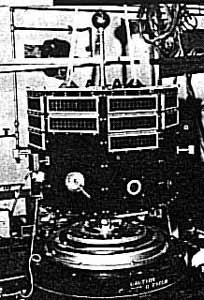Explorer 31
This article includes a list of general references, but it lacks sufficient corresponding inline citations. (June 2018) |
 Explorer 31 satellite | |
| Names | DME-A Direct Measurement Explorer-A |
|---|---|
| Mission type | Earth science |
| Operator | NASA |
| COSPAR ID | 1965-098B |
| SATCAT no. | 01806 |
| Spacecraft properties | |
| Spacecraft | Explorer XXXI |
| Launch mass | 98.9 kg (218 lb) |
| Start of mission | |
| Launch date | 29 November 1965, 04:48:47 GMT [1] |
| Rocket | Thor SLV-2 Agena B (Thor 453 / Agena 6102 (TA5)) |
| Launch site | Vandenberg, SLC-2E |
| Contractor | Douglas Aircraft Company / Lockheed Corporation |
| Entered service | 29 November 1965 |
| End of mission | |
| Decay date | 21 February 1967 |
| Orbital parameters | |
| Reference system | Geocentric orbit [2] |
| Regime | Low Earth orbit |
| Perigee altitude | 505 km (314 mi) |
| Apogee altitude | 2,978 km (1,850 mi) |
| Inclination | 79.80° |
| Period | 121.40 minutes |
| Instruments | |
| Cylindrical Electrostatic Probes Electron Temperature Energetic Electron Current Monitor Ion Mass Spectrometer Magnetic Ion-Mass Spectrometer Thermal Electron Probe Thermal Ion Probe | |
Explorer program | |
Explorer 31, also called DME-A, was a NASA satellite launched as part of the Explorer program. Explorer 31 was launched on 29 November 1965 from Vandenberg Air Force Base, California, with a Thor-Agena launch vehicle. Explorer 31 was released along with the Canadian satellite Alouette 2.[3]
Explorer 31 was a small ionospheric observatory instrumented to make direct measurements of selected ionospheric parameters at the spacecraft. Since the spacecraft had no tape recorder, data could be observed at the spacecraft only when the spacecraft was in sight of the telemetry station and when commanded on. Experiments were operated either simultaneously or sequentially, as desired. The satellite was spin-stabilized with the spin axis perpendicular to the orbit plane. The spin rate and spin axis were controlled by an onboard magnetic torquing system. The attitude and spin rate information were observed by a sun sensor and a three-axis magnetometer.[3]
Satellite performance was satisfactory except for a partial power failure in May 1966, which reduced data acquisition time to about half the nominal amount. Some difficulties were encountered in obtaining attitude information that was necessary for the reduction of the experiment observations. On July 1, 1969, the satellite data observations were terminated with five of the seven experiments operating. Responsibility for standby monitoring of the satellite was given to the ESSA telemetry station at Boulder, Colorado, on July 8, 1969. During this standby operation, experiment data were collected only once on 1 October 1969, for 9 minutes from the electrostatic probe for use in studying a red arc event. On January 15, 1971, no response was received from a variety of satellite commands, and the satellite was abandoned.[3]
Instruments
- Cylindrical Electrostatic Probes
- Electron Temperature
- Energetic Electron Current Monitor
- Ion Mass Spectrometer
- Magnetic Ion-Mass Spectrometer
- Thermal Electron Probe
- Thermal Ion Probe
Experiments
Cylindrical Electrostatic Probes
The cylindrical electrostatic probes were used to measure electron temperature and density in the ionosphere. Each sensor was basically a Langmuir probe consisting of a collector electrode extending from the central axis of a cylindrical guard ring. The guard rings extended 23 cm (9.1 in) from the spacecraft and the collector electrode extended 46 cm (18 in). The two sensors were mounted on opposite sides of the spacecraft, and were perpendicular to the spin axis and in the orbit plane. Data sets are no longer available from this experiment.[4]
See also
References
- ^ "Launch Log". Jonathan's Space Report. 21 July 2021. Retrieved 9 November 2021.
- ^ "Trajectory: Explorer 31 (DME-A) 1965-098B". NASA. 28 October 2021. Retrieved 9 November 2021.
 This article incorporates text from this source, which is in the public domain.
This article incorporates text from this source, which is in the public domain.
- ^ a b c "Display: Explorer 31 (DME-A) 1965-098B". NASA. 28 October 2021. Retrieved 9 November 2021.
 This article incorporates text from this source, which is in the public domain.
This article incorporates text from this source, which is in the public domain.
- ^ "Experiment: Cylindrical Electrostatic Probes". NASA. 28 October 2021. Retrieved 9 November 2021.
 This article incorporates text from this source, which is in the public domain.
This article incorporates text from this source, which is in the public domain.
